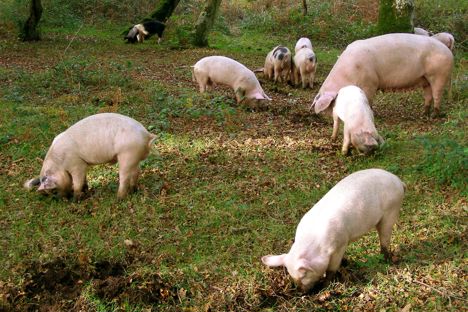
Pannage pork: Britain’s answer to Iberico
Every autumn in the New Forest, hundreds of domestic pigs are released into the woodland to roam around in the wild and eat their weight in acorns – not too dissimilar to Spain's world-famous Iberico ham. We take a closer look at this unique practice and why 'pannage pork' isn't as well known as its Mediterranean counterpart.
Pannage pork: Britain’s answer to Iberico
Every autumn in the New Forest, hundreds of domestic pigs are released into the woodland to roam around in the wild and eat their weight in acorns – not too dissimilar to Spain's world-famous Iberico ham. We take a closer look at this unique practice and why 'pannage pork' isn't as well known as its Mediterranean counterpart.
Whether it be a tiny village or a vast region, every corner of the world is home to specific areas renowned for the food and drink it produces. That is, of course, exactly the case here in the UK. Most people will know about the beautiful beef that comes from Angus in Scotland; some might even have heard about Swaledale’s exquisite lamb. But far fewer are aware of some very special pigs reared in the New Forest for just a few months every year.
Stretching for miles on end across England’s south coast, the New Forest remains one of the country’s most impressive areas of unspoilt beauty. Steeped in history, the 71,000-acre national park was proclaimed a royal forest by William the Conqueror in 1079 and these days is known for its idyllic landscape and amazing wildlife; in particular the wild New Forest ponies which graze on the forest floor. When it comes to the forest's chefs and farmers, however, it’s also renowned for an altogether more tasty speciality – pannage pork.
The ancient practice of pannage involves releasing domestic pigs into forests so that they can eat up all the fallen acorns and nuts, and dates all the way back to the time of William the Conqueror. It may seem like a rather random practice but the idea behind pannage makes perfect sense – whilst acorns are completely harmless to pigs, excessive amounts can be poisonous to ponies and cattle. Not only are the pigs being fattened up quickly with tasty (and free) acorns, they’re actually making the forest a safer place for other wildlife.
Back in medieval times, pannage would happen all across the country but today it happens almost exclusively in the New Forest, where it’s officially known as the Common of Mast. For a period of sixty days every autumn (usually from mid-September to mid-November), the local farmers’ pigs are out in force, hoovering up nuts and acorns to help protect the New Forest ponies. Some farmers will allow their pigs to return to the farms for shelter in the evenings, but many of the pigs will stay out in the woods for the entire sixty days feasting. Pannage is about more than just the practicalities of clearing the forest floor though; in a similar vein to rearing Iberico pigs, the process is known to produce outstanding pork.
Over in Spain and Portugal, black Iberian pigs are fattened almost exclusively on acorns and allowed to roam around on the hills, ultimately producing pork with a rich, subtly nutty flavour but also a high fat content and plenty of marbling. By allowing the pigs to wander freely, their muscles are encouraged to grow and develop, meaning they can take in even more fat from the acorns. This leads to an incredibly flavoursome product which is widely regarded as one of the finest varieties of pork in existence. Although the pannage process is comparable to that of Iberico pork, there are a few key differences. First of all, Iberico pork is produced from one specific breed or cross-breed of pig, whereas pannage pigs can be anything from Tamworths to Gloucester Old Spots. Pannage pigs also only have access to the acorns for two months every year, rather than it making up the majority of their constant diet. But what impact does the pannage process have on the flavour of pork itself?
Just like Iberico, the flavour of pannage pork is intensified by the diet of acorns and has a distinct earthiness to it, while the meat itself is darker and more tender than standard pork and is best cooked slightly pink. Pannage pork contains less marbling than Iberico due to the shorter acorn-snaffling time, but the marbling that is present is still wonderfully rich in flavour. It’s this unique taste and quality which has led to pannage pork being very in demand, particularly amongst chefs working in and around the New Forest such as Luke Holder and Matthew Tomkinson.
The problem is that only around 600 pigs are released every year, compared to more like 6,000 at the time of William the Conqueror, and all the pigs are slaughtered a couple of weeks after pannage season finishes. Not only does this mean that pannage pork is in very short supply (and tends not to find its way to chefs outside of the area) but it’s also a hyper-seasonal type of meat. Given the popularity of this relatively niche product and the high prices it therefore demands, you wonder whether we might ultimately start to see the return of pannage in other parts of the UK.
It may have begun over a thousand years ago but the practice of pannage is in many ways more relevant than ever right now. Pannage pork is a sustainable, seasonal product packed with flavour – a chef’s dream. And while it can only really be found in a few New Forest butchers and restaurants each autumn before it's gone, perhaps it just needs a bit of Iberico's marketing magic to become something bigger, more widely available and well-known. Either way, if you ever get the chance to taste pannage pork, be sure to jump at the chance!

